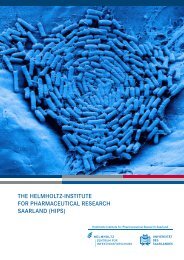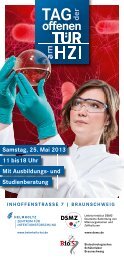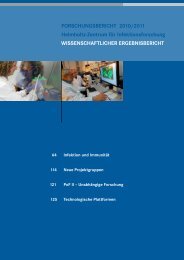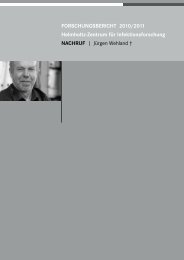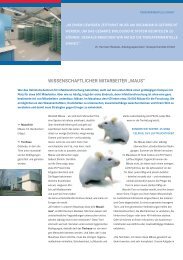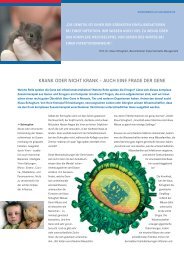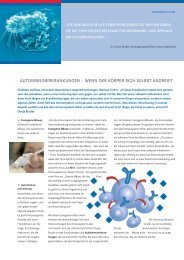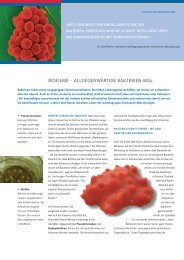Research Report 2010 2011 - Helmholtz-Zentrum für ...
Research Report 2010 2011 - Helmholtz-Zentrum für ...
Research Report 2010 2011 - Helmholtz-Zentrum für ...
You also want an ePaper? Increase the reach of your titles
YUMPU automatically turns print PDFs into web optimized ePapers that Google loves.
112 SCIENTIFIC REPORTS | Infection and Immunity | Pharmaceutical <strong>Research</strong><br />
05.3 Chemical Biology of Infectious Disease<br />
PROJECT LEADERS | Dr. Ronald Frank | Department of Chemical Biology | rfr@helmholtz-hzi.de<br />
Dr. Florenz Sasse | Department of Chemical Biology | fsa@helmholtz-hzi.de<br />
PROJECT MEMBERS | Jihad Al-Qudsi | Ulrike Beutling | Randi Diestel | Dr. Michelle Fountain | Dr. Raimo Franke |<br />
Dr. Bernd Hofer | Denis Koska | Michael Mrosek | Dr. Irina Nickeleit | Dr. Mahtab Nourbakhsh | Dr. Marc Reboll |<br />
Saad Shaaban | Galina Sergeev | Dennis Schwab | Dr. Dr. Werner Tegge | Dr. Peter Washausen | Marina Wöhl<br />
The aim of the project is to elucidate the molecular mechanisms<br />
of infection processes by interfering small molecules.<br />
Special assay systems and screening techniques are developed<br />
to select bioactive substances out of chemical libraries<br />
whose mode of action will be further analysed. These<br />
analyses should lead to new antibiotics, chemotherapeutics,<br />
and immune modulators. The knowledge about their mode<br />
of actions will open new ways of therapy. Within the framework<br />
of the „Chemical Pipeline“, we built an infrastructure<br />
that allows a rapid and effective search in miniaturised<br />
assay systems. Our library of about 90,000 samples includes<br />
a unique collection of natural compounds isolated from<br />
myxobacteria (see 05.1), substances from collaboration<br />
partners, purchased compound collections, and substances<br />
that were synthesised by us. The infrastructure is also at<br />
the disposal of external scientists and to other applications<br />
via the German ChemBioNet (www.chembionet.de).<br />
Phenotypes characterise the mode of action There is<br />
no easy way to elucidate the mode of action of a biologically<br />
active compound. Each biologically active compound<br />
changes the metabolic and signalling pathways within the<br />
Biologically active substances induce phenotypical changes in<br />
treated cells which are characteristic for their mode of action.<br />
This is shown for chivosazol A. The green actin filament structures<br />
of the treated cells in B clearly differ from the control cells<br />
in A. In C we see a hierarchical cluster analysis of substances<br />
from myxobacteria. D gives a detail which shows that chivosazol<br />
A clusters together with a second sample that was given “blind”,<br />
a clear proof of principle.<br />
complex biochemical network of a target cell. This can lead<br />
to striking changes in the morphology of the cell and the<br />
cell organelles or in the protein pattern. These phenotypical<br />
changes can be visualised via antibodies or specific dyes.<br />
Comparing phenotypes is one way to get hints about the<br />
mode of action. Now we have strengthened this method<br />
by automated microscopy and statistical analysis of large<br />
amounts of data. By automated microscopy we can take a lot<br />
of pictures of treated cells, evaluate them by software-based<br />
image analysis, and form a profile of the biologically active<br />
compound. By comparing the profiles of known and unknown<br />
compounds we get hints about the mode of action of<br />
the new substance. This is done by software-based statistical<br />
methods, e.g., hierarchical cluster analysis. Substances,<br />
which have the same mode of action, group together then.<br />
In the meantime we have also got useful hints concerning<br />
the mode of action of new substances. First follow-up<br />
experiments confirmed the first hints.<br />
Inhibitors of the adherence of Staphylococcus aureus to<br />
human epithelial cells In the context of the BMBF funded<br />
consortium “SkinStaph” a high-throughput amenable adhesion<br />
assay was established, which provides the possibility<br />
to search for new inhibitors of the interaction between the<br />
pathogenic bacterium Staphylococcus aureus and human<br />
epithelial cells (see Fig. page 109). Highly reliable data is<br />
obtained by a newly developed method that employs an<br />
automated microscope. Epithelial cells are incubated with<br />
the bacteria in the presence of potentially interfering compounds,<br />
followed by the removal of non-adherent bacteria<br />
and the staining of the cells. The nuclei of the epithelial<br />
cells are stained with a DNA specific dye (DAPI) and the<br />
bacteria are labelled with specific fluorescent antibodies.<br />
Several pictures for every compound are taken with the<br />
auto mated microscope. With a software module the nuclei<br />
and the bacteria are automatically quantified and set into<br />
relation. This allows the identification of substances that<br />
reduce the adhesion of the bacteria. After screening more<br />
than 4,000 individual substances and mixtures, several<br />
promising compounds were identified. These drug candidates<br />
are currently investigated with primary human nasal<br />
cells and their toxicity is determined with cell-based assays.<br />
Diestel, R., Irschik, H., Jansen, R., Khalil, M.W., Reichenbach, H., & Sasse, F. (2009)<br />
Chivosazole A and F, cytostatic macrolides from Myxobacteria, interfere with actin.<br />
ChemBioChem 10, 2900-2903.



